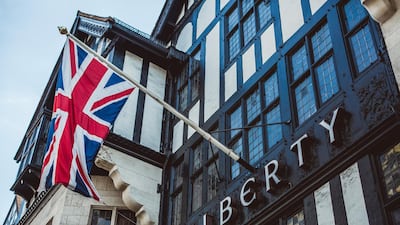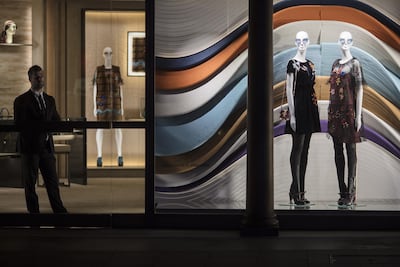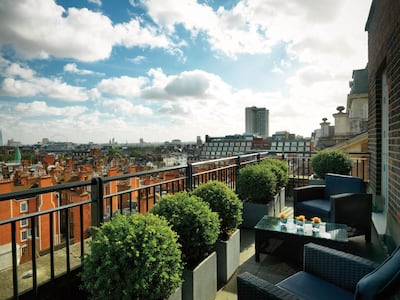London is probably the best place to shop in the world right now. It's expensive in terms of hotel costs, hence the envy felt in the UAE towards those with the wherewithal to maintain property there. But in terms of shopping, it's like New York but better. A city where you can find absolutely everything, from every corner of the world, but in often-charming old stores and historic, architecturally beguiling old shopping streets. As the value of sterling has fallen almost 15 per cent since 2016, when Britain took the decision to exit the European Union, goods here now sell at great prices, too. London owes its status as a place to shop to many things, among them its historic entrepreneurialism and Britain's buccaneering days of exploration and colonisation, which saw valuable raw materials pour in from all corners of the globe. As the first country in the world to industrialise, for a while in the 19th century, London reigned as the world's leading manufacturing centre. Today, the city doesn't manufacture much at all, except banking gobbledygook, but its standing as a financial and trading hub makes it essential for shops from the rest of the world to maintain a London outlet. And its great plus is that with so many museums, theatres, cinemas, parks and historic houses, as well as countless restaurants and cafes, it offers numerous other diversions.
These days, there is a new generation of London artisan makers, producing everything from sunglasses to shoes, to draw you in. As a fashion centre, it can dress and accessorise anyone at any price, from those who insist on high-end – Dior, Gucci and Louis Vuitton, all newly hot again – to those who like to mix designer labels with a dash of H&M or Primark. Britain's history of shoe-making, tailoring, shirt-making and leather-working means it has few rivals as a place to find beautifully handcrafted menswear. Excellent department stores mixed with small chains and niche outlets mean it is a place where you can find the best beauty products, from international brands to the niche names from Paris, Florence, and Los Angeles. And it sells much more than fashion.
Main shopping areas
For Selfridges and every mid-level brand from Adidas via Marks & Spencer, Nike Town, Primark and Topshop to Zara, visit Oxford Street.
For high-end designer boutiques, go to New Bond Street and Old Bond Street, collectively known as Bond Street, home to Fenwick, Smythson stationery, Fendi, Tiffany, Gucci, Dior, Miu Miu, Asprey and many more. Mount Street has Moynat bags and luggage; Marc Jacobs, Lanvin, Oscar de la Renta fashion; Frette (around the corner on South Audley Street), and Nicholas Kirkwood and Louboutin shoes. Regent Street (regentstreetonline.com) offers Liberty, Karl Lagerfeld, Nike Town, Nespresso, the seven-floor Hamley's, which is the biggest toy shop in the world, a massive Apple, and the Burberry HQ, which is one of the most technologically advanced stores in the world with its interactive mirrors . Soho and Carnaby Street offer Agent Provocateur lingerie, quirky little one-off cosmetic, fashion and catch-all boutiques such as Lazy Oaf, plus marvellous fabric shops such as Cloth House on Berwick Street. Covent Garden gives an enticing if touristy mix of the mainstream – Chanel, Apple, Cath Kidston – and made-in-England brands such as Links of London for jewellery and cufflinks, Mulberry bags, Cambridge satchels, Pollock's toys and a Hardys Original sweetshop. King's Road, Sloane Street, andhttp://sloane-street.co.uk Old Brompton Road are home to countless cool high- and mid-level fashion boutiques, plus Peter Jones, Harrods and Harvey Nichols department stores. Quirkier (and often calmer) top shopping streets include Marylebone High Street, Elizabeth Street, Lamb's Conduit Street and, in east London, Redchurch Street in Shoreditch.
Department stores

London remains home to the world's first, and arguably still best, department store, the marble-floored Selfridges. It still feels youthfully surprising and provides enough fun and stimulation for hours of browsing fashion brands from Topshop and Alexa Chung to Dior, Gucci and Louis Vuitton. It's also home to a massive cosmetic and skincare department, jewellery and watches to set any collector's heart beating in the Wonder Room, and the most humongous shoe department in Europe.
The other must-visit department store is Liberty, which has maintained its appeal for affluent 20- and 30-somethings, its creaky-floored 1920s Tudor revival building always yielding a mix of fashion-department discoveries such as new British label Rixo and quirkier expensive labels such as Shrimp, with a focus on organic brands in the beauty and skincare department. Fenwick on Bond Street provides a calm setting for a well-curated mix of mid-price fashion; John Lewis and Peter Jones excel in homewares; Harvey Nichols in Knightsbridge is good for little-known as well as more expensive fashion, skincare and accessory brands. For the most expensive of everything, no store rivals Harrods, also in Knightsbridge, oozing money and confidence, and worth visiting for its gloriously Edwardian food hall alone.

Best personal shopping suites
To take advantage of London’s status as a style centre and organise a new-look new you, it’s hard to beat the pleasure of settling down in a cool setting with a trustworthy private shopper. At Selfridges, the men’s suite even outdoes the women’s, for once, with a gentlemen’s club vibe and library. For sophisticated high fashion, there’s Harvey Nichols; for a quirkier, artier look, Liberty; and for a mix of both in an intimate town house setting, try Matches.
Malls
Shopping is evolving, with bricks-and-mortar stores closing as we all spend more online. Malls are something new, however, in London. On an overcast or chilly day, it's worth heading for the Dubai-standard Westfield mall in Shepherd's Bush, west London: it has 300 stores, from A to Z, and 50 restaurants. There's another one in east London's Stratford.
Markets
Great fun to browse on a weekend are Borough Market (Fridays and Saturdays) for gourmet food stalls; Portobello Road (Saturdays) to see the location for Notting Hill; Columbia Road Flower Market and nearby Brick Lane (Sundays) for small one-off shops and cafes and stalls. There's also Maltby Street Market (Saturdays and Sundays) for high-end food shops, with cafes built under the old railway arches.
Unique old shops
London has some of the oldest shops in the world, many around Piccadilly. Most notable is Fortnum & Mason on Piccadilly, purveyor of super-deluxe foods, including distinctive tins of tea, coffee and biscuits, as well as perfumes, china and more. It was founded in 1707 by one of Queen Anne's footmen on the proceeds of selling half-burnt palace candles. A few minutes' away, Lock & Co Hatters on St James's Street opened in 1676 and feels very Harry Potter-ish; on the same street are D R Harris, which has been selling men's shaving products since 1790, and James J Fox Cigars, where Winston Churchill bought his cigars, and which, as the world's oldest cigar store, has a fascinating little cigar museum. On Jermyn Street, you can smell Paxton & Whitfield, which has sold cheeses since 1797, before you see it; things are more fragrant at Floris perfume shop, which has been unchanged since 1851.
Fashion
Above all, London shopping is about clothes buying. The city's main shopping streets are lined with shops selling styles of every description: high-fashion pieces that are soon to prove either daft or directional, inexpensive copies in Zara and all the other many mid-price- level stores, and really cheap versions in giant Primark and H&M stores. Thanks to the profitability of this, you can exit, say, Gucci, on Bond Street, which is lined with designer boutiques, and seconds later be comparing versions at Zara, on Oxford Street, a tourist magnet that is a heaving home to mid-level and cheaper stores.
Just about every international designer name has a shop in London. But ever since the 1960s, when Mary Quant and, later, Biba designer Barbara Hulanicki headed a fashion revolution, Britain has excelled in mid-priced fashion, and it's that area that is perhaps London's great draw as a fashion shopping centre. Competition is such that even the Zara stores in London stock a better range than almost anywhere else. Whistles, Jigsaw, & Other Stories and newcomer Arket on Regent Street are always packed, and for a reason. And Topshop at Oxford Circus always yields something irresistible: a little something in pink fake fur, say, along with great jeans for about £50 (Dh252). For inspiration before you set out, netaporter.com, asos.com andmatchesfashion.com – all London launches that have gone international – are worth consulting. So too is the newer villoid.com. This "online mall of boutique shops" curated by Londoner stylists and influencers such as Alexa Chung, Daisy Lowe and Pixie Geldof also provides a platform for new young designers such as Jessica Russell Flint, a graduate from London's world-famous Central St Martins fashion school. Her vivid oversize Texicana washbags (£75 [Dh378]), are in the once-seen, must-have category.
Goodhood provides another inspiring one-stop snapshot of London stylishness. Launched in east London, with a "culturally curated" mix of 200 brands, it sells online, as well as from its store at Curtain Road.
Menswear, luggage and leather goods
The rugged 19th-century explorers who set out to find the source of the Nile and the like equipped themselves from leather-luggage-makers that, in many cases, are still in business today, having expanded into all forms of menswear. Off Piccadilly, Swaine Adeney Brigg, for instance, has sold beautifully handmade luggage and men's boots, shoes and hats since 1750. Savile Row is the home to famous tailors such as Gieves & Hawkes. Near by, Jermyn Street is lined almost entirely with high-end, old-school menswear shops – Charles Tyrwhitt, Tricker's, Edward Green – selling the best-quality shoes (soles stitched to the uppers, in British tradition, rather than stuck, as the Italians do), shirts, pyjamas, silk dressing gowns and hats. Soho's narrow streets brim with shops aimed at 20-and 30-somethings, such as Jack Spade, Albam Clothing, Cheaney shoes, Tom Davies spectacles and Aspinal of London leather accessories. Retro brand Fred Perry is just one reason to explore the side streets of Covent Garden.
Cashmere
Newsflash: even in summer you may need to wrap up warmly in London. Find the best Scottish cashmere – famous worldwide – at Johnstons of Elgin on New Bond Street; Pringle on Mount Street; Hawico on Elizabeth Street; and, in opulent Burlington Arcade, off Piccadilly, N Peal, which was founded in 1936. Its super-soft unisex grey cashmere shawl, ideal for flying, costs £369 (Dh1,863).
Discounted luxury fashion
Burberry, founded in 1856, is arguably the most famous British fashion brand, with stores across central London, but now its famous beige gaberdine raincoats – the new slim-fit Chelsea versions are notable – cost £1,295 (Dh6,538) or more, it's worth visiting its factory shop in Chatham Place in Hackney, London's new luxury-outlet centre. There, you will find microscopically flawed raincoats that instead cost about £850 (Dh4,291). Jump on the No 30 bus from Oxford Street, which takes you there. You will also find Anya Hindmarch bags, Pringle cashmere, and, in nearby Hackney Walk, Gieves & Hawkes, Matches, Nike, Stone Island and more, also with 30 to 60 per cent off original prices.

Jewellery and silverware
Diamonds, vintage jewellery, old silver: all exert a special allure at venerable London jewellers such as De Beers, Graff, Asprey and Tiffany on Old Bond Street and, in seductive Burlington Arcade, Michael Rose, Ciro, and Richard Ogden. Mount Street stars David Marshall, and then there's Hatton Garden.
Scents and home fragrances
Perfume-lovers have an exciting time in London, which probably has the best internationally sourced selection of scents in the world, as well as intriguing new British brands. Liberty is good for niche names such as Le Labo, Serge Lutens and Francis Kurkdjian. In Fortnum & Mason, in a velvet-seated consultation area, a formidably well-informed sales assistant will take you through the historic, contemporary and the new world of all-natural scents, such as the British-made Parterre range, based on flowers and herbs grown in Devon, and the six exquisite fragrances in the new Prosody range (Lissom Linden is especially beguiling). Among stand-alone boutiques, London perfumer Linda Pilkington's jewel-box Ormonde Jayne boutique stands out; her Woman, at £160 (Dh808) for 100 millilitres, is mesmerising. Old-world names Floris Penhaligon's, Miller Harris, Bloom and Roja are all worth a Google.
Sweets and chocolates
Shopping in London isn't just about clothes and accessories. Britain has always excelled in producing sweets, for instance. Deliciously gooey, sticky, chewy, marshmallowy sweets. And chocolate. Old-fashioned sweet shops have become a rarity in high-rent central London, but new pastiches include the Hardys chain. For handmade chocolate heaven, the key names are Fortnum & Mason, Artisan du Chocolat, Charbonnel et Walker, Rococo, Paul A Young, Melt, Said, Pierre Herme, and, in east London, Dark Sugars. In Covent Garden Choccywoccydoodah, a cafe as well as shop, purveys one-kilogram bars of toffee popcorn enrobed in milk chocolate for £20 (Dh101).
Bookshops
What better way to spend £20 (Dh101) than on the treat of a new hardback? The cosy old London Review Bookshop by the British Museum also has excellent coffee in its in-store cafe, Cake. Founded in 1797, next to Fortnum & Mason, Hatchards is the oldest bookshop in London; seconds away, Assouline, home of glossy art and fashion books, also has an ultra-elegant cafe. Mayfair’s Heywood Hill Books, an institution since 1936 (“Life is too short to waste time on bad books,” is its motto), runs a Year in Books subscription service that sends a new title every month or two, from £125 (Dh630) to £950 (Dh4,792) – a great gift. On Lamb’s Conduit Street, Persephone Books is a treasure trove of republished forgotten classics. Airy Daunt on Marylebone High Street excels in travel books. Ideas Books is an inspiration-filled corner of cool at Dover Street Market. On Hanbury Street, Libreria oozes buy-me seduction. And if the Notting Hill Bookshop looks familiar, that’s because it was a location in the film Notting Hill.
Homewares
Stolidly reliable John Lewis on Oxford Street is London’s go-to department store for computers and electrical equipment, and its smarter sister store Peter Jones on Sloane Square is where upper-class Brits buy pillows and duvets, furnishing fabrics and everyday china, going to David Mellor, across the square, for kitchen equipment. As well as Heals on Tottenham Court Road, there are the Conran shops in Marylebone High Street and South Kensington, and Liberty and Selfridges. Stores that are hard to leave empty-handed include Petersham Nurseries in Covent Garden, selling an eclectic mix of vases, throws, candles, books and furniture; Momosan in Dalston, east London, with coloured glass vases with fins at £240 (Dh1,211); Labour & Wait on Redchurch Street in Shoreditch, which has a rough-hewn artisan aesthetic; Alex Eagle’s sophisticated Soho-based curation of homewares plus fashion, books and art at The Store; and, for home fragrances, with oud noir perfume and sticks at £45 (Dh227), The Luxuriate.
Where to stay
Perhaps in one of the city's great hotels? Claridge's or Brown's near Bond Street; the Connaught on Mount Street; The Dorchester, between Piccadilly and Knightsbridge; The Ritz or Ham Yard, close to Piccadilly, Bond Street and Regent Street; The Savoy or Rosewood near Covent Garden. In Knightsbridge, which is convenient for Heathrow airport, there's The Berkeley, Lanesborough, Mandarin Oriental and Bulgari or, for a UAE connection, Grosvenor House Suites by Jumeirah.
London also excels in smaller, quirkier hotels. The 1930s-feeling Beaumont near Selfridges; Flemings in Mayfair; the Stafford and Dukes off Piccadilly; the 18th-century Hazlitt's and Kettner's Townhouse in Soho, the Draycott and No 11 Cadogan Gardens near King's Road and Knightsbridge. No London hotel is cheap, though. Double rooms cost about £300 (Dh1,514) a night, up to £500-plus (Dh2,523) at Claridges, which opened in 1856, and perhaps the best hotel in the world
_________________
Read more:
Mykonos: peaceful pursuits on a five -star party island
Where to eat, sleep and shop in Cologne, Germany
_________________



